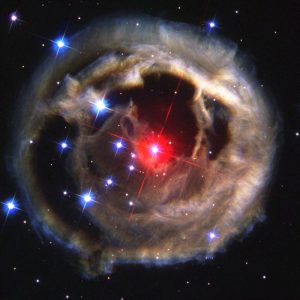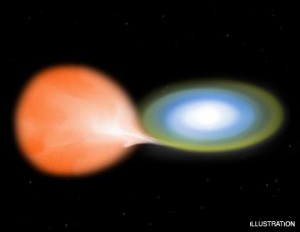
If a star began to eat another star, what would it look like? Natasha Ivanova can tell you better than almost anyone; as the Canada Research Chair in Astronomy and Astrophysics at the University of Alberta, pondering questions like this is her full-time job. Last week, Ivanova and her colleagues published a paper in Science which showed that a certain type of stellar cannibalism previously thought to be invisible can be observed from Earth after all. The finding may explain the existence of the recently-discovered phenomena known as luminous red novae.
Stars are more gregarious that you may realize. Although our beloved sun is typical in size for so-called main sequence stars, it’s somewhat unusual in that it doesn’t have a close companion. “At least half of stars like our sun are in binary systems,” says Ivanova. “For more massive stars, the probability is higher. Stars 20 solar masses and higher are almost all in binaries.” In binary systems two stars orbit their common centre of mass, but over time this orbit can degrade and the stars can move closer together. Moreover, when a main sequence star gets low on fuel it rapidly expands its radius and turns into a red giant, decreasing the distance between it and its neighbour even more. If they get too close, the smaller, denser star (often a white dwarf) can start to steal material from the larger, less dense red giant. As the material (mostly hydrogen) accretes around the smaller star, it is compressed by gravity and eventually explodes into nuclear fusion. The temporary burst of light created from such an event looks like a new star in the sky, and is therefore called a nova (from the Latin for ‘new’).

Ivanova is interested in what happens to stars that are really close together, so much so that at a certain point the white dwarf actually finds itself orbiting within outer layer – called the envelope – of the red giant. These common-envelope events (CEEs) are unstable, as material is transferring to the white dwarf too quickly for it to be able hold onto it all. There are two possible outcomes. The first is for the two stars to merge. The second is more complicated, so I’ll let Ivanova explain: “As the stars orbit, they have orbital energy,” she says. “This is transferred to the common envelope, heating and mixing it up. If the envelope gets enough energy in this way, it can be fully ejected from the system, leaving behind a new binary system.”
The idea of CEEs was proposed decades ago, and there are all kinds of exotic binary systems with thrilling names – X-ray binaries, cataclysmic variables, close double neutron stars – that are thought to be formed by them. But until now, nobody ever thought they’d be able to actually observe a CEE, for two reasons. Firstly, they’re relatively quick, lasting perhaps as little as a couple of months. Secondly, it was thought that CEEs wouldn’t look much brighter than a regular red giant; you might stare right at one and not even notice.
Ivanova and her team upended that theory by considering something called recombination energy. “In stars, the material is usually ionized; the electrons and protons are separated,” says Ivanova. “When they recombine, energy is released in the form of a very energetic photon.” The phenomenon is not unlike that which makes light-emitting diodes (LEDs) work here on Earth. Ivanova and her colleagues worked out that the recombination energy from a CEE would in fact be bright enough to be seen from Earth, most likely in the red part of the spectrum.
So when will we finally be able to see a CEE? As it turns out, we might have been seeing them for years. About a decade ago, astronomers began describing events knows as luminous red novae. As the name suggests, these glow in the red part of the spectrum and are from 10 to 100 times brighter than regular novae, although still much less bright than the spectacular supernovae. They also have other characteristics that are hard to explain, for example their disappearances are often quite sudden. When Ivanova realized that these and other characteristics of luminous red novae matched up with her predictions of CEEs, her heart skipped a beat. “It was kind of a gift,” she says. “It felt pretty good. It was exciting.”
Hunting for luminous red novae/CEEs could help astronomers learn more about the evolution of the exotic binary systems they give rise to. It could even help with the search for ones we could never observe directly, such as double black holes. So far, only a couple of dozen luminous red novae have been found, mostly by sheer luck. “I think now that people know what to look for, we’ll find lots more,” says Ivanova.
6 Comments
Fascinating article Tyler. As a longtime follower of the layman’s astronomer, Carl Sagan, I am very impressed with your ability to put something as esoteric as CEE’s into terms I could actually understand. I am also astounded that such a massive “happening” could actually occur in a period as short as a couple of months. Keep these coming Tyler.
Thanks Dale. I’m not normally much of a space guy (I prefer chemistry and biology) so this piece required a lot of learning for me too. I can’t wait until the weather gets nicer so I can dust off the ol’ telescope and try to spot some CEEs for myself!
Hello again Tyler.
I heard an interesting interview on the radio today (CBC I believe) about some research done on pollinators recently (bees, and others). Thought you might find this to be an interesting subject for some future posting. It sure sounds like something of which we all should become more aware. Maybe it’s a just my flower child background from the 60s but sure sounded like we need a lot more flower power in our agricultural thinking, even if just in backyard home gardening.
Yes, CBC. Here is the URL : https://www.cbc.ca/news/canada/nova-scotia/story/2013/03/01/science-wild-pollinators-honeybees.html
Thanks Dale, I wanted to do something on this but have been just too busy with work. I hope to get back to the blog soon!
[…] mechanism behind a luminous red nova is thought to be the merging of two stars. This can occur when stars within a binary system end up coming too close together -– possibly […]